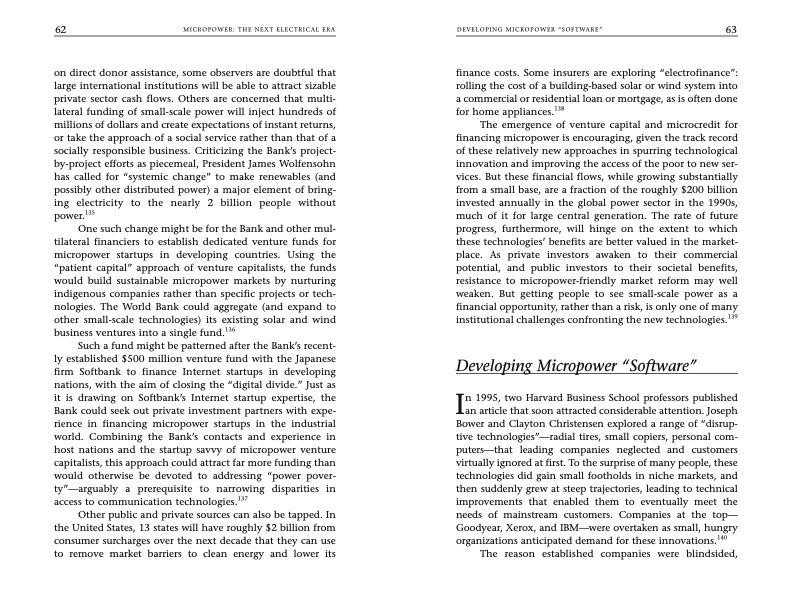
PDF Publication Title:
Text from PDF Page: 032
62 MICROPOWER: THE NEXT ELECTRICAL ERA DEVELOPING MICROPOWER “SOFTWARE” 63 on direct donor assistance, some observers are doubtful that large international institutions will be able to attract sizable private sector cash flows. Others are concerned that multi- lateral funding of small-scale power will inject hundreds of millions of dollars and create expectations of instant returns, or take the approach of a social service rather than that of a socially responsible business. Criticizing the Bank’s project- by-project efforts as piecemeal, President James Wolfensohn has called for “systemic change” to make renewables (and possibly other distributed power) a major element of bring- ing electricity to the nearly 2 billion people without power.135 One such change might be for the Bank and other mul- tilateral financiers to establish dedicated venture funds for micropower startups in developing countries. Using the “patient capital” approach of venture capitalists, the funds would build sustainable micropower markets by nurturing indigenous companies rather than specific projects or tech- nologies. The World Bank could aggregate (and expand to other small-scale technologies) its existing solar and wind business ventures into a single fund.136 Such a fund might be patterned after the Bank’s recent- ly established $500 million venture fund with the Japanese firm Softbank to finance Internet startups in developing nations, with the aim of closing the “digital divide.” Just as it is drawing on Softbank’s Internet startup expertise, the Bank could seek out private investment partners with expe- rience in financing micropower startups in the industrial world. Combining the Bank’s contacts and experience in host nations and the startup savvy of micropower venture capitalists, this approach could attract far more funding than would otherwise be devoted to addressing “power pover- ty”—arguably a prerequisite to narrowing disparities in access to communication technologies.137 Other public and private sources can also be tapped. In the United States, 13 states will have roughly $2 billion from consumer surcharges over the next decade that they can use to remove market barriers to clean energy and lower its finance costs. Some insurers are exploring “electrofinance”: rolling the cost of a building-based solar or wind system into a commercial or residential loan or mortgage, as is often done for home appliances.138 The emergence of venture capital and microcredit for financing micropower is encouraging, given the track record of these relatively new approaches in spurring technological innovation and improving the access of the poor to new ser- vices. But these financial flows, while growing substantially from a small base, are a fraction of the roughly $200 billion invested annually in the global power sector in the 1990s, much of it for large central generation. The rate of future progress, furthermore, will hinge on the extent to which these technologies’ benefits are better valued in the market- place. As private investors awaken to their commercial potential, and public investors to their societal benefits, resistance to micropower-friendly market reform may well weaken. But getting people to see small-scale power as a financial opportunity, rather than a risk, is only one of many institutional challenges confronting the new technologies.139 Developing Micropower “Software” In 1995, two Harvard Business School professors published an article that soon attracted considerable attention. Joseph Bower and Clayton Christensen explored a range of “disrup- tive technologies”—radial tires, small copiers, personal com- puters—that leading companies neglected and customers virtually ignored at first. To the surprise of many people, these technologies did gain small footholds in niche markets, and then suddenly grew at steep trajectories, leading to technical improvements that enabled them to eventually meet the needs of mainstream customers. Companies at the top— Goodyear, Xerox, and IBM—were overtaken as small, hungry organizations anticipated demand for these innovations.140 The reason established companies were blindsided,PDF Image | Micropower: The Next Electrical Era

PDF Search Title:
Micropower: The Next Electrical EraOriginal File Name Searched:
EWP151.pdfDIY PDF Search: Google It | Yahoo | Bing
Capstone Turbine and Microturbine: Capstone microturbines used and new surplus for sale listing More Info
Consulting and Strategy Services: Need help with Capstone Turbine, sizing systems, applications, or renewable energy strategy, we are here to assist More Info
Container Lumber Dry Kiln: Since 1991 developing and innovating dry kilns using standard shipping containers More Info
Supercritical CO2 Lumber Dry Kiln: Compact fast drying in 3 days or less for small amounts of wood and lumber drying More Info
BitCoin Mining: Bitcoin Mining and Cryptocurrency... More Info
Publications: Capstone Turbine publications for microturbine and distributed energy More Info
FileMaker Software for Renewable Energy Developing database software for the renewable energy industry More Info
CO2 Gas to Liquids On-Demand Production Cart Developing a supercritical CO2 to alcohol on-demand production system (via Nafion reverse fuel cell) More Info
Stranded Gas for low cost power Bitcoin Mining Using stranded gas for generators may provide breakthrough low power costs for cryptocurrency miners. More Info
| CONTACT TEL: 608-238-6001 Email: greg@globalmicroturbine.com | RSS | AMP |